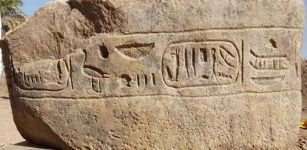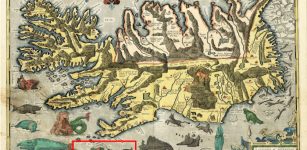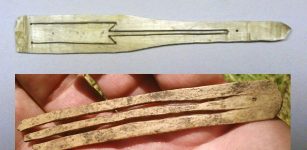Varangian Guard: Professional Viking Warriors Highly Valued For Courage, Loyalty, Discipline And Fighting Skills
A. Sutherland - AncientPages.com - The Varangian Guard represented the elite heavy infantry regiment of the Roman ('Byzantine') Empire from 988 AD to around 1404 AD.
They were Vikings for hire who successfully conquered territories across the Empire. They fought in Crete, Italy, and Asia Minor.
Fanciful ahistorical representation of Byzantine Varangian Guardsmen (dressed more like Norman knights) and Michael Barachios. Drawing from Vinkhuijzen Collection of Military Costume Illustration. New York Public Library (NYPL) digital gallery - Public Domain
The Varangians ('in Old Norse' væringi' 'sworn companion') were foreigners who became members of the imperial bodyguard. Recruits were drawn mainly from Scandinavia, but after 1066, there were also Anglo-Saxons among the Varangians.
In the fight, the Varangians relied on long axes, which they used as their primary weapon, although they did well in combat against swords and bows. These professional warriors were highly valued for their courage and loyalty; they also had high fighting skills and the ability to carry out commands efficiently and without unnecessary questions.
According to the Icelandic Sagas, getting into the Imperial Guard was not easy. It was an entrance fee to be paid by a new member, and it was probably a large sum, which not all warriors could pay. However, "they were well received as soon as it was known that they were Norsemen."
Basil the Bulgar-Slayer (958 - 1025), Byzantine Emperor, founded Varangian Guard because he did not trust his people. The Varangians, on the other hand, were for their legendary loyalty.
The true story of these warriors is closely related to particularly one famous warrior, Harald Hardrada, "(hard ruler") officially Harald III Sigurdsson (1015-1066), one of the most famed Viking leaders. He participated in the Battle of Stiklestad in 1030 AD at the age of 15.
Before Hardrada became king of Norway, he made a living as a mercenary soldier. The saga of the king mentions that he fought in 18 battles against the Bulgarians, the Anatolian Arabs, and in southern Italy under the command of the eminent Byzantine commander, General Georgios Maniakes, during the 11th century. According to ancient sources, Hardrada had difficulties paying an entrance fee as a new guard member.
Hardrada was among the best berserkers in the army. His formidable Viking warriors were employed as protectors of the emperor, and Harald became a military commander in Kievan Rus and the Varangian Guard in the Byzantine Empire.
Hardrada developed successful tactics that transformed warfare across the Mediterranean region. For several centuries the Varangians served as both palace guards and field troops who fought in expeditionary armies; later, they became the household guards of the emperor in Constantinople and no longer went out on campaigns.
The Varangians continued their service until the second half of the 11th century, when, after the Norman Conquest (1066 AD, both English and Danish nobles who left England were eventually absorbed into it.
Some historians suggest that after the sacking of the city of Constantinople in 1204 by the crusaders, the guard ceased to exist.
By the late 13th century, Varangians mainly were ethnically assimilated by the Byzantines, though the regiment operated until at least the mid-14th century. In 1400, some people still identified as "Varangians" in Constantinople.
Written by – A. Sutherland AncientPages.com Staff Writer
Updated on July 21, 2022
Copyright © AncientPages.com All rights reserved. This material may not be published, broadcast, rewritten or redistributed in whole or part without the express written permission of AncientPages.com
Expand for referencesReferences:
Blöndal S. The Varangians of Byzantium
Hilda E. Davidson, Viking Road to Byzantium
More From Ancient Pages
-
 Royal Colossi Fragments, Mud Brick Wall And Pottery Uncovered In Matariya, Egypt
Archaeology | Dec 4, 2019
Royal Colossi Fragments, Mud Brick Wall And Pottery Uncovered In Matariya, Egypt
Archaeology | Dec 4, 2019 -
 On This Day In History: Mesoamerican Long Count Calendar Begins – On August 11, 3114 B.C
News | Aug 11, 2016
On This Day In History: Mesoamerican Long Count Calendar Begins – On August 11, 3114 B.C
News | Aug 11, 2016 -
 Who Were The Goths And Where Did They Come From?
Civilizations | Apr 16, 2019
Who Were The Goths And Where Did They Come From?
Civilizations | Apr 16, 2019 -
 America’s Mysterious Waffle Rock Formation
Featured Stories | Apr 15, 2014
America’s Mysterious Waffle Rock Formation
Featured Stories | Apr 15, 2014 -
 Unique And Unusually Large 8000-Year-Old Building Discovered At Çatalhöyük Site, Turkey
Archaeology | Sep 26, 2022
Unique And Unusually Large 8000-Year-Old Building Discovered At Çatalhöyük Site, Turkey
Archaeology | Sep 26, 2022 -
 Ancient Manuscripts About Sea Monsters Solve An Ocean Mystery
News | Mar 1, 2023
Ancient Manuscripts About Sea Monsters Solve An Ocean Mystery
News | Mar 1, 2023 -
 Huge Round Ancient Sewer System Covering 160,000 Square Meters Discovered In Ancient City Of Mastaura
Archaeology | Apr 25, 2022
Huge Round Ancient Sewer System Covering 160,000 Square Meters Discovered In Ancient City Of Mastaura
Archaeology | Apr 25, 2022 -
 Never-Before-Seen 3,000-Year-Old Paintings Of Egyptian Goddess Amentet Discovered Inside Coffin Of A Mummy
News | Apr 7, 2020
Never-Before-Seen 3,000-Year-Old Paintings Of Egyptian Goddess Amentet Discovered Inside Coffin Of A Mummy
News | Apr 7, 2020 -
 Large Collection Of At Least 2,500-Year-Old Cave Paintings Discovered In Indonesia
Archaeology | Dec 17, 2017
Large Collection Of At Least 2,500-Year-Old Cave Paintings Discovered In Indonesia
Archaeology | Dec 17, 2017 -
 Archaeologists Focus On Greek Poet Aratus’ Memorial Tomb And Ruins Of Soli Pompeiopolis
Archaeology | Aug 12, 2020
Archaeologists Focus On Greek Poet Aratus’ Memorial Tomb And Ruins Of Soli Pompeiopolis
Archaeology | Aug 12, 2020 -
 Psychedelic Blue Lotus Of Egypt – A Misunderstood Ancient Mystery?
Archaeoastronomy | Mar 19, 2025
Psychedelic Blue Lotus Of Egypt – A Misunderstood Ancient Mystery?
Archaeoastronomy | Mar 19, 2025 -
 Milk Enabled Massive Steppe Migration
Archaeology | Sep 15, 2021
Milk Enabled Massive Steppe Migration
Archaeology | Sep 15, 2021 -
 Late Roman-Era Rooms, Offering Vessels Unearthed At Ancient City Of Antiocheia, Southern Türkiye
Archaeology | Oct 31, 2022
Late Roman-Era Rooms, Offering Vessels Unearthed At Ancient City Of Antiocheia, Southern Türkiye
Archaeology | Oct 31, 2022 -
 Jew’s Harps: Old Musical Instruments Discovered In Altai Mountains
Archaeology | Jan 9, 2018
Jew’s Harps: Old Musical Instruments Discovered In Altai Mountains
Archaeology | Jan 9, 2018 -
 Unique Ancient Coast Salish War Club Accidently Discovered In British Columbia Backyard
Archaeology | Mar 22, 2022
Unique Ancient Coast Salish War Club Accidently Discovered In British Columbia Backyard
Archaeology | Mar 22, 2022 -
 Encounter Between Neanderthals And Homo Sapiens – Genome Study Traces The History
DNA | Oct 18, 2023
Encounter Between Neanderthals And Homo Sapiens – Genome Study Traces The History
DNA | Oct 18, 2023 -
 Proof Of Superior Ancient Technology – Found In All Four Corners Of The World
Ancient Mysteries | Mar 19, 2014
Proof Of Superior Ancient Technology – Found In All Four Corners Of The World
Ancient Mysteries | Mar 19, 2014 -
 How Did A Roman Sarcophagus End Up On A Beach Near Varna In Bulgaria?
Archaeology | Aug 6, 2024
How Did A Roman Sarcophagus End Up On A Beach Near Varna In Bulgaria?
Archaeology | Aug 6, 2024 -
 Ancient Genomes Suggest Farming In Africa Was Ignited By Oversea-Migrants From Iberia 7,400 Years Ago
Archaeology | Jun 7, 2023
Ancient Genomes Suggest Farming In Africa Was Ignited By Oversea-Migrants From Iberia 7,400 Years Ago
Archaeology | Jun 7, 2023 -
 Kingdom Of Mitanni: Forgotten For Millennia But Once Great Power Of Ancient West Asia In 2000 BC
Civilizations | Jun 20, 2023
Kingdom Of Mitanni: Forgotten For Millennia But Once Great Power Of Ancient West Asia In 2000 BC
Civilizations | Jun 20, 2023


